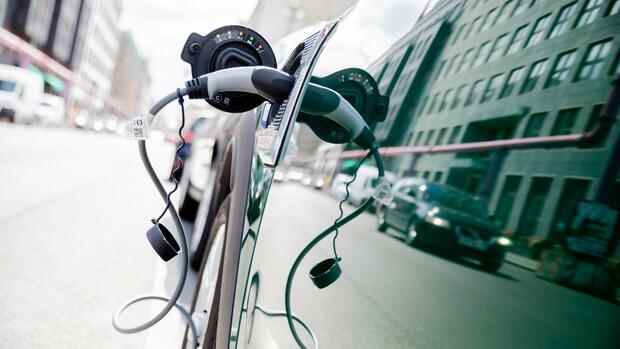The demand for e-cars is rising sharply, mainly thanks to the state premium and the high fuel costs.
(Photo: dpa)
Berlin There has been a boom in government subsidies for electric cars this year. The number of applications more than doubled to a record of more than 585,000, as the Federal Office of Economics and Export Control announced to the German Press Agency. More than 3 billion euros in funding for electromobility were paid out. This is 4.7 times the amount paid out last year.
In the middle of last year, the purchase premium (environmental bonus) for pure e-cars and plug-in hybrids was increased through an innovation premium. The federal government doubled its funding for the purchase of such vehicles. This led to a strong increase in demand.
The innovation bonus, which was previously limited to the end of the year, will be extended until the end of 2022, as Economics and Climate Protection Minister Robert Habeck (Greens) recently announced. Buyers of purely electrically powered electric vehicles will continue to receive funding of up to 9,000 euros. Plug-in hybrids can cost up to 6750 euros.
According to the Federal Office, around one million applications have been submitted since funding began in 2016 – the majority of the vehicles had been applied for in the past two years.
Top jobs of the day
Find the best jobs now and
be notified by email.
According to the plans of the Ampel coalition, there should be a reform of state funding from 2023. Then only electric vehicles that have been shown to have a positive effect on climate protection should be funded. This should be defined via the electric driving portion and a minimum electric range.
New cars at the end of the year are more expensive than ever before
At the same time, new cars are currently more expensive than ever on the German car market. This is the conclusion of the regular market study by the Duisburg Center Automotive Research (CAR), which was presented on Thursday. According to the head of the study, Ferdinand Dudenhöffer, the tendency towards scarce supply and lower discounts will continue in the first few months of the new year. The reason for this is, in particular, supply problems with semiconductor components. The state innovation bonus for electric vehicles obscures the trend towards higher prices somewhat.
According to the study, almost all indicators pointed to rising consumer prices for new cars in December as well. Specifically, the discounts offered on the Internet for the 30 most popular, freely configurable new vehicles have been reduced to an average of 16.7 percent of the list price. The highest discounts of just under 25 percent were on various models from Ford and Renault as well as on the Fiat 500.
Manufacturers and dealers also allowed fewer vehicles for their own account in order to later bring them to the market as special offers. The share of self-registrations fell again in November by 1.4 points to 22.5 percent, as CAR reported.
Most expensive tank year since 2013
2021 is also the most expensive year of refueling since 2013. On average for the first eleven months, premium E10 petrol cost 1.514 euros per liter on a nationwide average, as the ADAC announced. For diesel it was 1.373 euros. In the first three weeks of December, according to the traffic club, the average was a good bit higher at 1.602 euros per liter of E10 and 1.517 euros per liter of diesel, but that doesn’t change much on the annual average.
Accordingly, the average price for the year as a whole is likely to be around 1.52 euros per liter of E10 or 1.38 euros per liter of diesel. That would be around 26 to 27 cents more for E10 than in the previous year, for diesel around 27 cents. The strength of this increase is also due to the fact that fuel was unusually cheap in 2020.
In particular, 2021 was marked by a sustained rise in prices, which set a record for diesel in the fall. E10 remained just below its all-time high from 2012. On average, according to ADAC, November was nevertheless the most expensive month of fueling since records began. Since then, however, fuel prices have fallen back a good bit.
More: Rising energy costs: does an e-car pay off?
